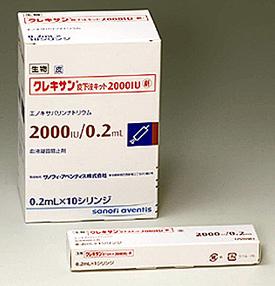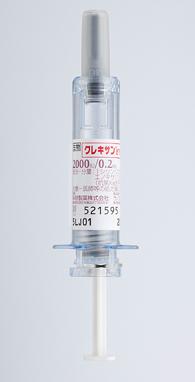英文药名:CLEXANE(Enoxaparin Sodium)
中文药名:依诺肝素钠皮下注射剂
生产厂家:科研制药
クレキサン皮下注キット2000IU
类别名称:抗凝剂
批准上市时间:2008年4月
药理作用
本药为低分子量肝素制剂,可使抗凝血因子Ⅹa与Ⅱa活力的比值大于4,从而发挥很强的抗血栓形成功能和一定的溶血栓作用。推荐剂量下总的凝血指标无明显变化,血小板聚集时间及与纤维蛋白原的结合也无变化。尽管低分子量肝素(LMWH)适用于所有分子量小于8000 Da的肝素片段,但每一片段的效应仍取决于分子量。
体外将本药(分子量为4000~6000 Da)和未分离肝素进行对比的研究显示,根据各自的分子量,与未分离肝素的作用相比较,本药对凝血酶的抑制作用降低约5倍。体内研究也显示皮下应用肝素,激活的部分凝血活酶时间(APTT)显著长于皮下应用本药。
适应证
膝盖关节全置换术,关节骨折手术
用法用量
以原处方为准
包装规格
注射器
1支/2000IU 10支装/盒
生产厂家:科研制药
完整资料附件:
1):http://clexane-vte.jp/page01.html
2):http://www.info.pmda.go.jp/go/pack/3334406G1020_1_10/

Name of drug classification
Blood coagulation inhibitor
Sales name
CLEXAN subcutaneous injection kit 2000 IU
Common name
Enoxaparin sodium (Enoxaparin Sodium)
Essence
Sodium salt of low molecular weight heparin obtained by alkaline decomposition of heparin benzyl ester derived from porcine intestinal mucosa; mass average molecular weight is about 4,500 and its range is 3,800 to 5,000; the degree of sulfated esterification is 2 per monosaccharide , About 2; most of its constituents have 2 - O - sulfo - 4 - enopyranose uronic acid structure at the non - reducing end of sugar chain and 2 - N, 6 - O - disulfo - D-glucosamine structure.
Molecular weight
Average molecular weight about 4500 (3800 to 5000)
Property
This product is a white powder.
It is easily soluble in water and hardly soluble in ethanol (99.5).
composition
Component·Content
Contains enoxaparin sodium 2000 IU (anti-factor Xa activity) in 1 syringe (0.2 mL)
Remarks: Derived from pig intestinal mucosa
Contraindications
Patients with a history of hypersensitivity to the ingredients of this drug or to heparin, heparin derivatives (low molecular weight heparin etc.)
Bleeding patients (intracranial hemorrhage, retroperitoneal hemorrhage or bleeding in other important organs etc) [There is a risk that bleeding may be promoted]
Patient with acute bacterial endocarditis [May have thromboembolic symptoms accompanying thrombus detachment]
Patients with severe renal impairment (creatinine clearance less than 30 mL / min) [blood levels may rise and the risk of bleeding may increase]
Patients with a history of heparin-induced thrombocytopenia (HIT) [HIT may occur]
Indication or effect
Inhibition of onset of venous thromboembolism in patients who underwent the following lower extremity orthopedic surgery
Hip total replacement surgery, total knee replacement surgery, hip joint fracture surgery
Inhibition of the onset of venous thromboembolism in patients undergoing abdominal surgery with a high risk of developing venous thromboembolism
Since efficacy and safety in patients undergoing caesarean section of abdominal surgery have not been established, consideration of risks and benefits should be taken into consideration when administered to these patients. [Less experience]
Usually, as an enoxaparin sodium, 2000 IU is injected subcutaneously twice a day, as a rule, every 12 hours.
In Japan clinical trials, efficacy and safety when administered for 15 days or more have not been studied.
As a general rule, administration should be started after confirming that there is no bleeding from surgical wound etc. 24 to 36 hours after the operation.
In patients with renal impairment, blood levels of this drug may rise and the risk of bleeding may increase. When administered to patients with creatinine clearance of 30 to 50 mL/min, carefully judge the application taking into account thrombus risk and bleeding risk for each case taking into consideration domestic clinical test results. If it is considered that the risk of bleeding is high, it is desirable to prolong the administration interval (2000 IU administered as enoxaparin sodium once a day). [[Contraindications], [1. Careful administration], [Pharmacokinetics] and [Clinical results]]
Conventional coagulability tests such as activated clotting time (ACT), prothrombin time (PT) and activated partial thromboplastin time (aPTT) are relatively insensitive to this drug and are not indicative of monitoring drug efficacy, To adequately observe the clinical symptoms, if bleeding etc. is seen take appropriate measures such as discontinue administration. [See [Pharmacological pharmacology] section]
Careful Administration
Patients who may have bleeding
Patients with a history of hemostatic disorder, peptic ulcer, shallow patients on the day after the onset of ischemic stroke, uncontrollable hypertension, diabetic retinopathy, shallow patients after brain / ophthalmic surgery, drugs affecting hemostasis were administered Patient [There is a danger of bleeding in the damaged part of blood vessels and organs]
Patients with severe hepatic impairment [Production of coagulation factors may be reduced, so bleeding may occur]
Patients with mild or moderate renal impairment [Excretion may be delayed and bleeding may occur due to increased blood levels]
Elderly people [There is a risk of increased bleeding risk in elderly people. "5. Administration to elderly people" section]
Patients with low body weight [Relatively high blood levels may rise, bleeding may occur]
Serious side effects
Shock, anaphylactoid symptoms
Shock and anaphylactoid symptoms (Frequency unknown Note 1) may occur, so observe thoroughly, if abnormalities are observed discontinue administration and take appropriate measures.
Hematoma · hemorrhage
Spinal cord epidural hematoma, retroperitoneal hemorrhage, intracranial hemorrhage (frequency unknown Note 1) abroad such as subcutaneous bleeding (3.7%), post-treatment bleeding (3.1%), digestive tract bleeding (0.1% And hematoma · bleeding are reported. Bleeding may occur even outside of the surgical site and may be fatal in some cases. Also, in patients with bleeding risk such as complications, invasive procedures, concomitant medications affecting hemostasis, etc., there is a possibility of bleeding, so observation should be done sufficiently and abnormalities such as bleeding or deterioration of bleeding are observed Appropriate measures should be taken, such as discontinue administration.
Thrombocytopenia
Thrombocytopenia (0.3%) may occur. In addition, since thrombocytopenia via immune mechanism and the arterial thrombus associated therewith may result in infarction or limb ischemia, platelet counts were measured after administration, a marked decrease in platelet count was observed If so, please discontinue subsequent administration.
Liver dysfunction, jaundice (Frequency unknown Note
Liver dysfunction or jaundice accompanied by elevation of AST (GOT), ALT (GPT), etc. may occur, so observe thoroughly and if abnormality is found, take appropriate measures such as discontinue administration To do.
Medicinal pharmacology
Mechanism of action
Selectivity of action on blood coagulation factor (anti-factor Xa activity / anti-factor IIa activity ratio)
Enoxaparin sodium forms a complex with antithrombin III (ATIII), promotes factor Xa and factor IIa inhibitory action of ATIII, and develops anticoagulant action. Its action was greater in the anti-factor Xa activity / anti-factor IIa activity ratio than in other low molecular weight heparins (anti-factor Xa activity / anti-factor IIa activity ratio in vitro was higher in heparin 1 Versus 4.88).
Effect on activated partial thromboplastin time (aPTT)
The aPTT prolonging action of enoxaparin sodium in human plasma was weaker than that of heparin (in vitro).
Antithrombotic action in deep vein thrombosis model
Enoxaparin sodium prolonged abdominal vena cava occlusion time and showed antithrombotic effect in a dose-dependent manner when administered subcutaneously in a single rabbit deep venous thrombus model. Compared to heparin, the antithrombotic activity of enoxaparin sodium was comparable, the plasma anti - factor Xa activity was high, and the prolonging action of aPTT was weak.
Effect on platelet aggregation
Enoxaparin sodium did not affect adenosine 5'-diphosphate (ADP) -induced primary aggregation ability of human platelets, but heparin enhanced primary aggregation ability (in vitro).


